Richard Gloaguen
MineNetCD: A Benchmark for Global Mining Change Detection on Remote Sensing Imagery
Jul 04, 2024



Abstract:Monitoring changes triggered by mining activities is crucial for industrial controlling, environmental management and regulatory compliance, yet it poses significant challenges due to the vast and often remote locations of mining sites. Remote sensing technologies have increasingly become indispensable to detect and analyze these changes over time. We thus introduce MineNetCD, a comprehensive benchmark designed for global mining change detection using remote sensing imagery. The benchmark comprises three key contributions. First, we establish a global mining change detection dataset featuring more than 70k paired patches of bi-temporal high-resolution remote sensing images and pixel-level annotations from 100 mining sites worldwide. Second, we develop a novel baseline model based on a change-aware Fast Fourier Transform (ChangeFFT) module, which enhances various backbones by leveraging essential spectrum components within features in the frequency domain and capturing the channel-wise correlation of bi-temporal feature differences to learn change-aware representations. Third, we construct a unified change detection (UCD) framework that integrates over 13 advanced change detection models. This framework is designed for streamlined and efficient processing, utilizing the cloud platform hosted by HuggingFace. Extensive experiments have been conducted to demonstrate the superiority of the proposed baseline model compared with 12 state-of-the-art change detection approaches. Empirical studies on modularized backbones comprehensively confirm the efficacy of different representation learners on change detection. This contribution represents significant advancements in the field of remote sensing and change detection, providing a robust resource for future research and applications in global mining monitoring. Dataset and Codes are available via the link.
PCB-Vision: A Multiscene RGB-Hyperspectral Benchmark Dataset of Printed Circuit Boards
Jan 12, 2024Abstract:Addressing the critical theme of recycling electronic waste (E-waste), this contribution is dedicated to developing advanced automated data processing pipelines as a basis for decision-making and process control. Aligning with the broader goals of the circular economy and the United Nations (UN) Sustainable Development Goals (SDG), our work leverages non-invasive analysis methods utilizing RGB and hyperspectral imaging data to provide both quantitative and qualitative insights into the E-waste stream composition for optimizing recycling efficiency. In this paper, we introduce 'PCB-Vision'; a pioneering RGB-hyperspectral printed circuit board (PCB) benchmark dataset, comprising 53 RGB images of high spatial resolution paired with their corresponding high spectral resolution hyperspectral data cubes in the visible and near-infrared (VNIR) range. Grounded in open science principles, our dataset provides a comprehensive resource for researchers through high-quality ground truths, focusing on three primary PCB components: integrated circuits (IC), capacitors, and connectors. We provide extensive statistical investigations on the proposed dataset together with the performance of several state-of-the-art (SOTA) models, including U-Net, Attention U-Net, Residual U-Net, LinkNet, and DeepLabv3+. By openly sharing this multi-scene benchmark dataset along with the baseline codes, we hope to foster transparent, traceable, and comparable developments of advanced data processing across various scientific communities, including, but not limited to, computer vision and remote sensing. Emphasizing our commitment to supporting a collaborative and inclusive scientific community, all materials, including code, data, ground truth, and masks, will be accessible at https://github.com/hifexplo/PCBVision.
TSGAN: An Optical-to-SAR Dual Conditional GAN for Optical based SAR Temporal Shifting
Jan 04, 2024Abstract:In contrast to the well-investigated field of SAR-to-Optical translation, this study explores the lesser-investigated domain of Optical-to-SAR translation, a challenging field due to the ill-posed nature of this translation. The complexity arises as a single optical data can have multiple SAR representations based on the SAR viewing geometry. We propose a novel approach, termed SAR Temporal Shifting, which inputs an optical data from the desired timestamp along with a SAR data from a different temporal point but with a consistent viewing geometry as the expected SAR data, both complemented with a change map of optical data during the intervening period. This model modifies the SAR data based on the changes observed in optical data to generate the SAR data for the desired timestamp. Our model, a dual conditional Generative Adversarial Network (GAN), named Temporal Shifting GAN (TSGAN), incorporates a siamese encoder in both the Generator and the Discriminator. To prevent the model from overfitting on the input SAR data, we employed a change weighted loss function. Our approach surpasses traditional translation methods by eliminating the GAN's fiction phenomenon, particularly in unchanged regions, resulting in higher SSIM and PSNR in these areas. Additionally, modifications to the Pix2Pix architecture and the inclusion of attention mechanisms have enhanced the model's performance on all regions of the data. This research paves the way for leveraging legacy optical datasets, the most abundant and longstanding source of Earth imagery data, extending their use to SAR domains and temporal analyses. To foster further research, we provide the code, datasets used in our study, and a framework for generating paired SAR-Optical datasets for new regions of interest. These resources are available on github.com/moienr/TemporalGAN
Masking Hyperspectral Imaging Data with Pretrained Models
Nov 06, 2023Abstract:The presence of undesired background areas associated with potential noise and unknown spectral characteristics degrades the performance of hyperspectral data processing. Masking out unwanted regions is key to addressing this issue. Processing only regions of interest yields notable improvements in terms of computational costs, required memory, and overall performance. The proposed processing pipeline encompasses two fundamental parts: regions of interest mask generation, followed by the application of hyperspectral data processing techniques solely on the newly masked hyperspectral cube. The novelty of our work lies in the methodology adopted for the preliminary image segmentation. We employ the Segment Anything Model (SAM) to extract all objects within the dataset, and subsequently refine the segments with a zero-shot Grounding Dino object detector, followed by intersection and exclusion filtering steps, without the need for fine-tuning or retraining. To illustrate the efficacy of the masking procedure, the proposed method is deployed on three challenging applications scenarios that demand accurate masking; shredded plastics characterization, drill core scanning, and litter monitoring. The numerical evaluation of the proposed masking method on the three applications is provided along with the used hyperparameters. The scripts for the method will be available at https://github.com/hifexplo/Masking.
A Multisensor Hyperspectral Benchmark Dataset For Unmixing of Intimate Mixtures
Aug 30, 2023Abstract:Optical hyperspectral cameras capture the spectral reflectance of materials. Since many materials behave as heterogeneous intimate mixtures with which each photon interacts differently, the relationship between spectral reflectance and material composition is very complex. Quantitative validation of spectral unmixing algorithms requires high-quality ground truth fractional abundance data, which are very difficult to obtain. In this work, we generated a comprehensive laboratory ground truth dataset of intimately mixed mineral powders. For this, five clay powders (Kaolin, Roof clay, Red clay, mixed clay, and Calcium hydroxide) were mixed homogeneously to prepare 325 samples of 60 binary, 150 ternary, 100 quaternary, and 15 quinary mixtures. Thirteen different hyperspectral sensors have been used to acquire the reflectance spectra of these mixtures in the visible, near, short, mid, and long-wavelength infrared regions (350-15385) nm. {\color{black} Overlaps in wavelength regions due to the operational ranges of each sensor} and variations in acquisition conditions {\color{black} resulted in} a large amount of spectral variability. Ground truth composition is given by construction, but to verify that the generated samples are sufficiently homogeneous, XRD and XRF elemental analysis is performed. We believe these data will be beneficial for validating advanced methods for nonlinear unmixing and material composition estimation, including studying spectral variability and training supervised unmixing approaches. The datasets can be downloaded from the following link: https://github.com/VisionlabUA/Multisensor_datasets.
Tinto: Multisensor Benchmark for 3D Hyperspectral Point Cloud Segmentation in the Geosciences
May 17, 2023Abstract:The increasing use of deep learning techniques has reduced interpretation time and, ideally, reduced interpreter bias by automatically deriving geological maps from digital outcrop models. However, accurate validation of these automated mapping approaches is a significant challenge due to the subjective nature of geological mapping and the difficulty in collecting quantitative validation data. Additionally, many state-of-the-art deep learning methods are limited to 2D image data, which is insufficient for 3D digital outcrops, such as hyperclouds. To address these challenges, we present Tinto, a multi-sensor benchmark digital outcrop dataset designed to facilitate the development and validation of deep learning approaches for geological mapping, especially for non-structured 3D data like point clouds. Tinto comprises two complementary sets: 1) a real digital outcrop model from Corta Atalaya (Spain), with spectral attributes and ground-truth data, and 2) a synthetic twin that uses latent features in the original datasets to reconstruct realistic spectral data (including sensor noise and processing artifacts) from the ground-truth. The point cloud is dense and contains 3,242,964 labeled points. We used these datasets to explore the abilities of different deep learning approaches for automated geological mapping. By making Tinto publicly available, we hope to foster the development and adaptation of new deep learning tools for 3D applications in Earth sciences. The dataset can be accessed through this link: https://doi.org/10.14278/rodare.2256.
HyDe: The First Open-Source, Python-Based, GPU-Accelerated Hyperspectral Denoising Package
Apr 14, 2022
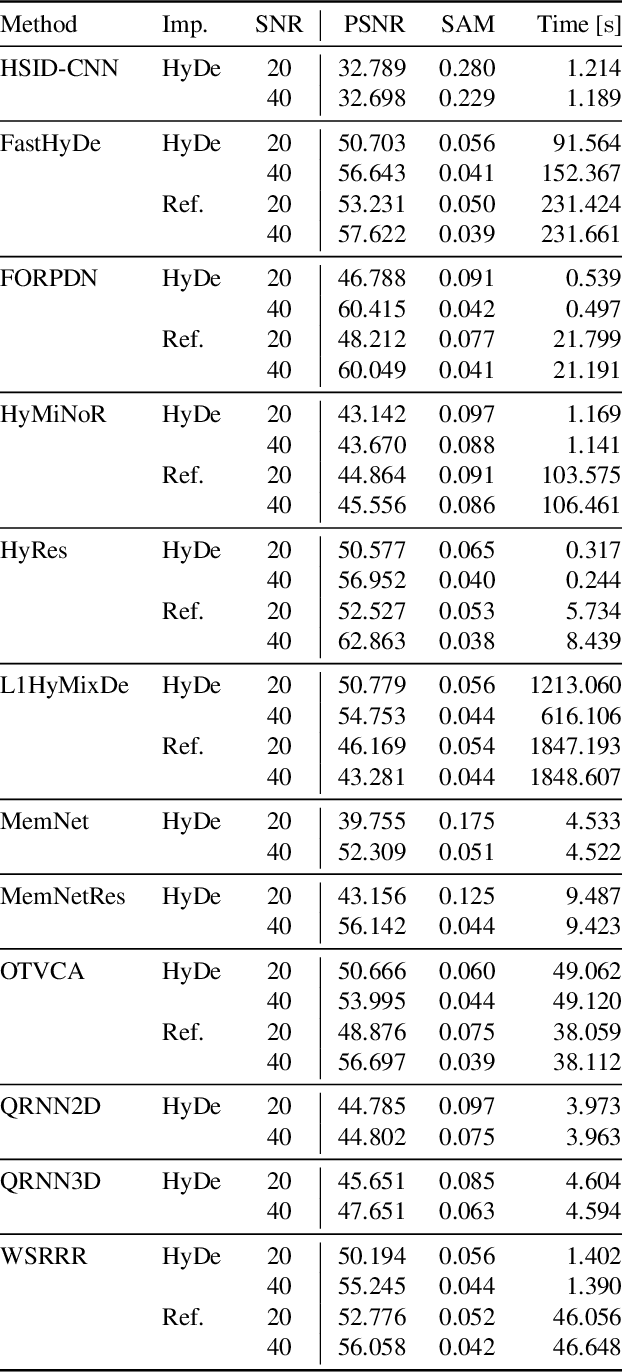
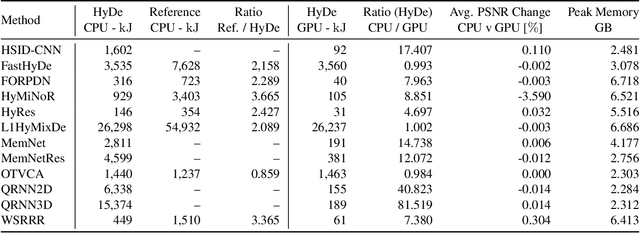
Abstract:As with any physical instrument, hyperspectral cameras induce different kinds of noise in the acquired data. Therefore, Hyperspectral denoising is a crucial step for analyzing hyperspectral images (HSIs). Conventional computational methods rarely use GPUs to improve efficiency and are not fully open-source. Alternatively, deep learning-based methods are often open-source and use GPUs, but their training and utilization for real-world applications remain non-trivial for many researchers. Consequently, we propose HyDe: the first open-source, GPU-accelerated Python-based, hyperspectral image denoising toolbox, which aims to provide a large set of methods with an easy-to-use environment. HyDe includes a variety of methods ranging from low-rank wavelet-based methods to deep neural network (DNN) models. HyDe's interface dramatically improves the interoperability of these methods and the performance of the underlying functions. In fact, these methods maintain similar HSI denoising performance to their original implementations while consuming nearly ten times less energy. Furthermore, we present a method for training DNNs for denoising HSIs which are not spatially related to the training dataset, i.e., training on ground-level HSIs for denoising HSIs with other perspectives including airborne, drone-borne, and space-borne. To utilize the trained DNNs, we show a sliding window method to effectively denoise HSIs which would otherwise require more than 40 GB. The package can be found at: \url{https://github.com/Helmholtz-AI-Energy/HyDe}.
Fusion of Dual Spatial Information for Hyperspectral Image Classification
Oct 23, 2020



Abstract:The inclusion of spatial information into spectral classifiers for fine-resolution hyperspectral imagery has led to significant improvements in terms of classification performance. The task of spectral-spatial hyperspectral image classification has remained challenging because of high intraclass spectrum variability and low interclass spectral variability. This fact has made the extraction of spatial information highly active. In this work, a novel hyperspectral image classification framework using the fusion of dual spatial information is proposed, in which the dual spatial information is built by both exploiting pre-processing feature extraction and post-processing spatial optimization. In the feature extraction stage, an adaptive texture smoothing method is proposed to construct the structural profile (SP), which makes it possible to precisely extract discriminative features from hyperspectral images. The SP extraction method is used here for the first time in the remote sensing community. Then, the extracted SP is fed into a spectral classifier. In the spatial optimization stage, a pixel-level classifier is used to obtain the class probability followed by an extended random walker-based spatial optimization technique. Finally, a decision fusion rule is utilized to fuse the class probabilities obtained by the two different stages. Experiments performed on three data sets from different scenes illustrate that the proposed method can outperform other state-of-the-art classification techniques. In addition, the proposed feature extraction method, i.e., SP, can effectively improve the discrimination between different land covers.
Multisource and Multitemporal Data Fusion in Remote Sensing
Dec 19, 2018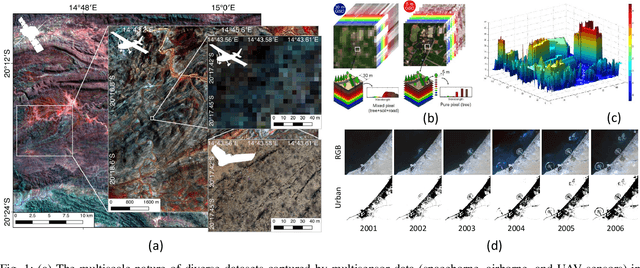
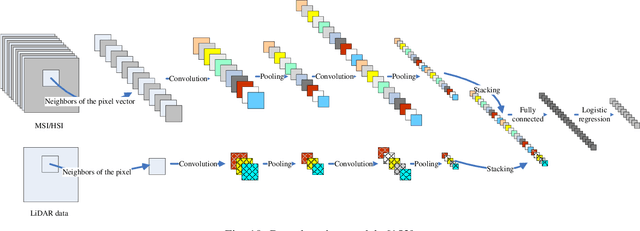
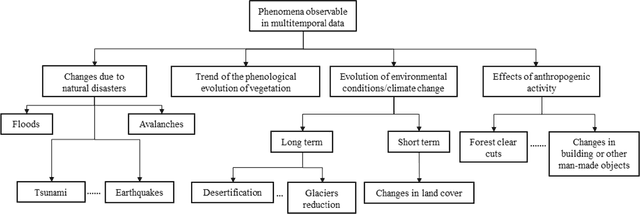
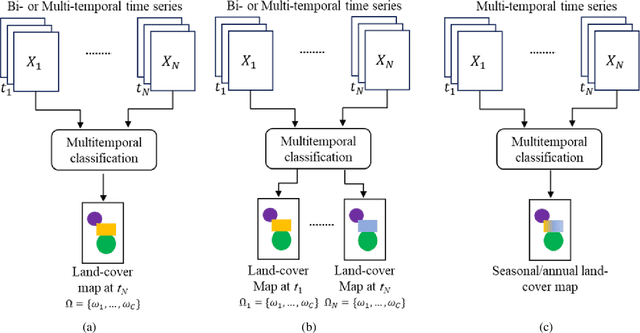
Abstract:The sharp and recent increase in the availability of data captured by different sensors combined with their considerably heterogeneous natures poses a serious challenge for the effective and efficient processing of remotely sensed data. Such an increase in remote sensing and ancillary datasets, however, opens up the possibility of utilizing multimodal datasets in a joint manner to further improve the performance of the processing approaches with respect to the application at hand. Multisource data fusion has, therefore, received enormous attention from researchers worldwide for a wide variety of applications. Moreover, thanks to the revisit capability of several spaceborne sensors, the integration of the temporal information with the spatial and/or spectral/backscattering information of the remotely sensed data is possible and helps to move from a representation of 2D/3D data to 4D data structures, where the time variable adds new information as well as challenges for the information extraction algorithms. There are a huge number of research works dedicated to multisource and multitemporal data fusion, but the methods for the fusion of different modalities have expanded in different paths according to each research community. This paper brings together the advances of multisource and multitemporal data fusion approaches with respect to different research communities and provides a thorough and discipline-specific starting point for researchers at different levels (i.e., students, researchers, and senior researchers) willing to conduct novel investigations on this challenging topic by supplying sufficient detail and references.
 Add to Chrome
Add to Chrome Add to Firefox
Add to Firefox Add to Edge
Add to Edge